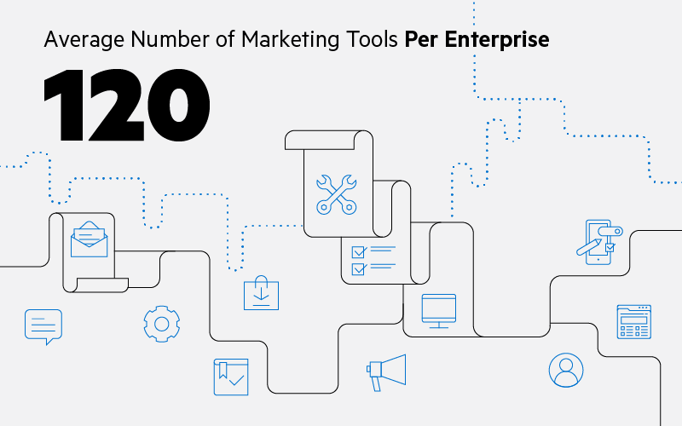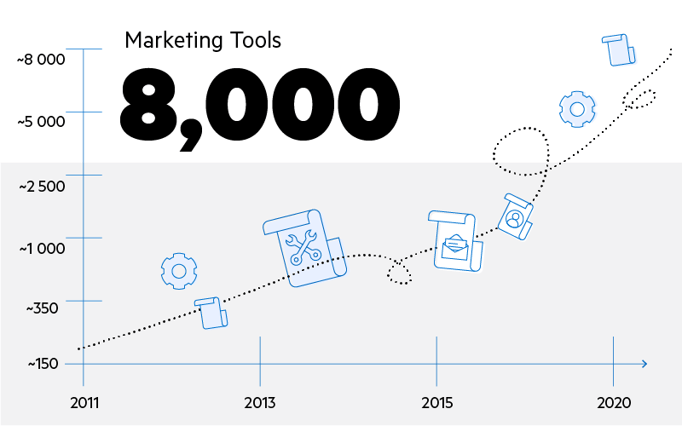
How many marketing tools does your company use? Maybe two or three, right? Not even close!

chiefmartec.com, The Average Enterprise Uses 1,295 Cloud Services (2020)

chiefmartec.com, Marketing Technology Landscape (2020)
Your martech stack produces a lot of valuable data. In many cases, the value of one system’s data shines the most when it’s combined with that of another platform. For instance, tracking the progress of a lead who opens an email becomes infinitely more interesting when you find out in your CRM that the lead is now a closed won opportunity.
While many applications have their own dashboards, the easiest way to visualize data is in a unified dashboard from a BI or analytics tool. Forrester projects that by 2022, businesses will be spending a significant amount of their marketing budget on analytics tools and services.
Forrester, The US Marketing Technology and Services Outlook (2018)
Progress DataDirect, 2020 Progress Data Connectivity Report (2020)
The Value of Analytics
Most companies today are no strangers to BI and reporting tools, but our reliance on them is growing. Gartner’s 2019 Marketing Technology Survey found that 19% of the people they interviewed believed advanced analytics would be the most impactful technology for marketing in the next five years. Almost half of their respondents expect analytics to be one of the top three most important technologies available.
Gartner, Marketing Technology Survey 2019
In a Gartner survey from the summer, 36% of respondents say that analytics is the most important tool at their disposal and over three quarters of people say it’s in their top 3.
Gartner, Data & Analytics During Covid-19 (2020)
Why is the analysis of data suddenly so important? As we produce more and more data, businesses realize it’s only as useful as we make it. If we can’t learn anything from past performance or if we can’t forecast anything about future performance, then all of our existing information serves no useful purpose.
Data Professionals in Marketing
Many companies keep data analysts on their IT teams or in a dedicated business intelligence team. But today, more medium-sized and large enterprises also have data analysts on their marketing teams. In fact, in many marketing operations departments, everyone is either a professional or citizen data analyst.
In addition to spending so much of their time in BI and analytics tools, technical marketers are also proficient in a variety of technical languages. In a world of vast quantities of data, the ability to SQL query data is essential. The faster a marketer can find the answers they need in their data, the sooner they can return to mission-critical tasks.
chiefmartec.com, Job Responsibilities of 4 Marketing Technologist Roles (2020)
With both IT and marketing operations teams having staff that handles data analytics, it’s now more important than ever to seek alignment between the Marketing team and the IT team. The CMO frequently leads, if not fully controls, the martech buying process as it is the marketers who best understand if a product will fulfill their needs. Nevertheless, the CIO understands the wider implications of integrating new martech tools into the existing tech stack. The strongest enterprises understand that it’s best not to wrestle for control of the martech stack but instead work together for optimal performance.
chiefmartec.com, Martech Collaboration Between Marketing and IT (2019)
One thing marketing and IT professionals can agree on is the prevalence of data across multiple sources. Even if your martech stack has only a dozen tools, it’s likely that the native integrations between these tools and to reporting tools like Tableau or Power BI are unable to process data as quickly and as efficiently as your business needs.
Progress DataDirect, 2020 Progress Data Connectivity Report (2020)
More often than not, IT and marketing operations professionals find themselves waiting for data to load, creating custom codes, or struggling with various APIs to create connections to data in martech tools or data warehouses.
With DataDirect, you can set up connections between a your data source and either a centralized data warehouse or a reporting tool such as Tableau or Power BI. Marketers get to see near real-time information, giving them better insight into the performance of their campaign efforts and marketing spend. If marketers have quick and easy access to the data they need, you can spend less time on data discovery and custom coding, freeing up your time to do other tasks.
Visit our page to learn more about Progress DataDirect’s connectors for popular martech tools such as Google Analytics, HubSpot, and Salesforce.
Joelle Andrews
Joelle Andrews is a Product Marketing Manager focused on Progress Customer Care. Joelle’s past experience includes two years with the DataDirect team and a decade of experience in other product marketing, marketing automation, and sales roles. Outside of work, Joelle loves hiking, getting lost in a book, rescuing cats, and traveling the world.